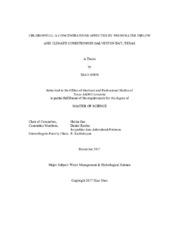| dc.description.abstract | As transition zones between river and ocean, estuaries face increasing pressure on
their ecosystem health due to changes of freshwater quantity and quality – especially under
the impacts of population growth, land use/land cover change, and climate change.
Located southeast of Houston, Galveston Bay is of particular social and economic
importance for the State of Texas. Its freshwater inflow primarily arises from the San
Jacinto River and the Trinity River. While it is well recognized that Chlorophyll a (chla)
concentration – an indicator of ecosystem health – is closely linked to river inflows and
other environmental factors, no quantitative relationships have been established. The
objectives of this study are to identify the spatial-temporal variations of chla, and to
investigate the impacts of freshwater inflow and climatic factors on chla variability – so
that prediction models can be developed for chla forecasting in Galveston Bay.
A 10-year validated remote sensing chla dataset is used in this study. Spatially,
there are two spots with low chla concentration compared with other places, locations
close to the river mouths and the area of the bay where Houston Ship Channel located.
Temporally, chla tends to be higher in wet years than in dry years. Similarly, the seasonal
fluctuations of chla are more significant during the wet months (from February to May)
than the dry months (especially from August to December). Chla concentrations in
different segments of Galveston Bay are determined by different factors during different
seasons. Discharge from the Trinity River is the main driver of chla in JFM (January,
February, March), AMJ (April, May, June) and JAS (July, August, September) in all segments, expect West Bay (where the chla concentration is mainly determined by
climatological variations). Also, water temperature plays a significant role in regulating
chla, especially in JFM. Based on these analyses, a chla prediction model is developed
and tested. Despite its limitations, this empirical model offers seasonal forecasts of chla
which could support decision making in Galveston Bay. | en |


